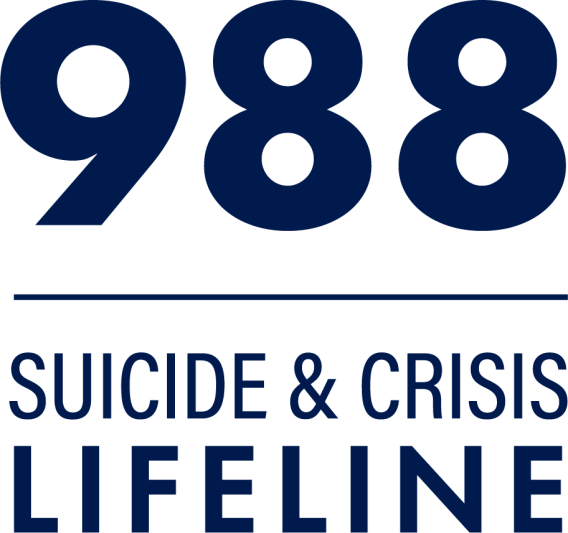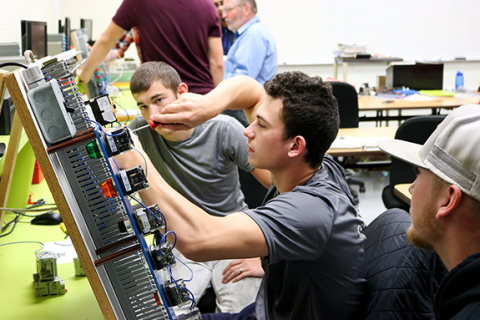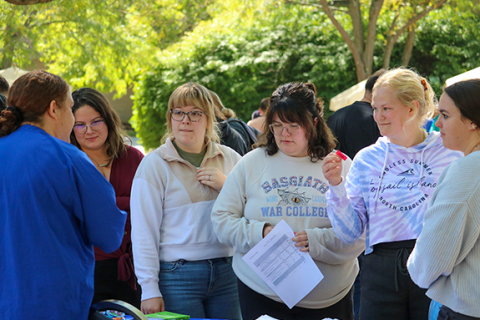
SuicidePrevention Awareness
You are never alone.

We are here for you.
At Edison State Community College, our mission is to provide the learning opportunities, support services, and commitment that enable students to complete their education goals and realize their dreams. These aspirations mean very little if even one person dies by suicide. Zero tolerance for death by suicide is the mission of the campus suicide prevention program. In addition, it is the goal of the program to have 100% of the campus community promote suicide prevention through training, education, and outreach.
Some facts about suicide?
Whether you are seeking help for yourself or someone you care about, please review these facts and then scroll for more information on how to get help.
- In Ohio, suicide is the second leading cause of death for those ages 15–34.
- On average, one life is lost to suicide every six hours in Ohio.
- Roughly 90% of suicides are carried out by those who have been undiagnosed or untreated for depression, other mental illnesses, and/or addiction.
- Overall, suicide is the eleventh leading cause of death in Ohio.
- Over twice as many people die by suicide in Ohio than by homicide. Total deaths to suicide reflect a total of 29,543 years of potential life lost (YPLL) before age 65.
Are you or someone you know considering suicide?
You are not alone. One out of four adults experience a mental illness in any given year. In addition, many people, at some point in their lives, have had suicidal thoughts. Feeling suicidal is not a weakness or a character defect. It does not mean that you are crazy or flawed. It only means that you are having more pain than you can deal with at the moment. The pain seems unbearable and permanent right now, but with time and support, you can overcome your problems, and the pain and thoughts of suicide will pass.
Did you know? Statistics show that you are more likely to encounter someone (friend, student, coworker, or member of the community) in an emotional or mental health crisis than someone having a heart attack. Suicidal ideation is not because someone wants to die or that they are weak; rather, they want to end the pain that has become unbearable. Being a caring person who can listen and find help may mean all the difference in a person’s life. Suicidality is not a phase or a way to seek attention. Individuals who are suicidal are reaching out for help.
Will it get better?
With help comes hope. People who seek diagnosis and treatment get well and stay well. Even for "major" diagnoses such as schizophrenia, scientific studies demonstrate that a majority of individuals recover over time. While some individuals become free of psychiatric concerns altogether, others learn new ways of living in and adjusting to the world.
Follow these steps to wellness.
Please follow the steps below if you are in crisis.
- If you are at a point where you do not think you can stay safe or have done something that has put you at risk for death, call 911 or go to your nearest emergency room. You may also text 988 or dial The National Suicide Prevention Lifeline at 988.
- Promise not to do anything right now. Thoughts and actions are different. Your suicidal thoughts do not need to be acted on immediately. Make a promise to yourself that you will not do anything drastic for at least 24 hours. Reach out for help during this time.
- Reach out to others. Don’t keep your feelings to yourself.
Call friends or family.
Call the Lifeline.
Call your mental health provider or primary care physician. - Find a therapist and other resources.
Consult the provider list on the Tri-County Board of Recovery & Mental Health Services website. - Create a safety plan. Download a safety plan here.
A safety plan is a personalized, practical plan that can help you avoid dangerous situations and know the best way to react when you are in danger of suicide. - Download a mental wellness app.
This list of mental health wellness apps is provided by the Tri-County Board as a resource for further research and does not constitute an endorsement by the Board or its staff. The apps listed here are free to download, but some may have in-app purchases to unlock key features. Apps are available on both iOS (Apple) and Android platforms unless noted. Apps may share similar titles, the publisher is given here to distinguish from similarly-named apps. Descriptions are provided by the publishers. - Avoid alcohol and drugs.
Alcohol and drugs may seem to make you feel less pain, but suicidal thoughts can be intensified with drugs or alcohol. Even prescription drugs may be harmful. Talk to your primary care provider or psychiatrist immediately to determine if the benefits of taking your medication outweigh the risks. - Have hope!
People who feel as badly as you have managed to overcome and survive. Think about the times you have been in pain before and how your resilience helped you overcome it. - Make your home safe.
Remove things that you can use to hurt yourself, such as pills, razors, or firearms. Lock them up or give them to someone who will return them to you when you are safe. - Watch stories of hope, such as the David Lilley story, which is available on YouTube.
- If you are not feeling safe, don't hesitate to call 911.
- Find help.
How can you tell if someone is at risk?
Is the person making direct statements about self or other harm with immediate thoughts/plan/means/access/intent?
Is the person under the influence of alcohol or drugs that could lead to harm?
Is the person that you are concerned about showing any of the following signs?
Use the mnemonic "IS PATH WARM" as an easy way to remember the following signs of suicide.
| I | Ideation | Talking about suicide and wanting to die. Looking for ways to die, such as researching how to take one’s life. |
| S | Substance Abuse | A sudden increase or excessive use of drugs or alcohol. Someone who does not use alcohol or drugs suddenly using them and in excess. |
| P | Purposelessness | Stating that there is no reason for living. Not having a sense of purpose in their life. |
| A | Anxiety | Agitation, difficulty sleeping or sleeping too much. |
| T | Trapped | Feeling trapped and feeling that there is no way out. Feeling that there is no need to seek help because it will not do anything. |
| H | Hopelessness | Feeling hopeless about the future or the negative events in their life. |
| W | Withdrawal | Withdrawing from friends, family, social activities and school. |
| A | Anger | Uncontrollable anger. Talking about seeking revenge. |
| R | Recklessness | Acting recklessly or participating in risky activities, seemingly without thinking. |
| M | Mood Changes | Dramatic mood changes. |
What do you do if you are concerned about someone?
If there has been any self or other harmful action taken by the person that you are concerned about, call 911 first and then call the Edison State Department of Public Safety at 937.778.7820. In certain situations, you must often make a judgment call.
Someone at Mild Risk
Someone at mild risk (someone with a mental health concern without risk of suicide) can be provided with the contact information to the Edison State Coordinator of the Student Wellness Center. You may also refer the individual to this web page for additional resources.
Always provide the person with the National Suicide Prevention Lifeline—call 988 and the National Suicide Prevention Text Line—text 988.
A person does not need to be suicidal to utilize these services. The crisis line professionals will speak to individuals who may be distressed for any number of reasons. A person may be experiencing distress due to employment difficulties, may be seeking help from a friend, or may just be feeling lonely. After hours, call the National Suicide Prevention Lifeline at 988. You may also utilize the online Edison State CARE Team Referral Form.
Someone at High Risk
Someone at a high risk for suicide will show the signs as previously described. They may make direct statements about self or other harm with an immediate plan. The person may have the means or access to ways to harm themselves. They may be under the influence of alcohol or drugs, which could lead to harm.
Even without immediate plans or access to harmful means, a direct statement about suicide should be taken seriously. You may receive the information from various sources: in person, by phone, or by email.
in-person—on campus
When responding to an at-risk individual in person on campus, please do the following:
- If it is between 8:00 a.m. and 6:00 p.m., please escort the student to the Student Affairs Office, West Hall, Room 160, or to the Dean’s Office at the Edison State at Greenville location.
- If you cannot escort the student to the above location, call the Edison State Department of Public Safety at 937.778.7820. Notify them that there is a crisis. Stay with the person until help arrives.
in-person—oFF campus
When responding to an at-risk individual in person off campus, please do the following:
- Call 911.
- Stay with the individual until help arrives.
- Follow up by completing a CARE Team Referral Form.
by phone
When responding to an at-risk individual via phone, please do the following:
- Ask the individual for the following information: name, phone number, location, whether or not they are alone, and whether self or other harmful action has been taken. Try to ascertain if they have access to lethal means.
- Have someone call 911 while you remain on the phone with the individual.
- Keep the individual on the phone.
- If you lose contact, call 911 immediately.
- Follow up by completing a CARE Team Referral Form.
by email
When responding to an at-risk individual via email, please do the following:
- Save the email. You may be asked to forward the email to the administration or the CARE Team for review.
- Express sincere concern and empathy.
- Direct the individual to the Tri-County Board of Recovery & Mental Health Services for resource information.
- Always provide the individual with the National Suicide Prevention Lifeline—call 988 and the National Suicide Prevention Text Line—text 988.
- Encourage the individual to continue reaching out.
- Request that they respond to your email so you know they received it.
- Be transparent about your actions. Tell the individual that you want to ensure they receive the most comprehensive services available at Edison State, so you have reached out to the Coordinator of Student Wellness and/or the Edison State Department of Public Safety.
- Inform the individual that they are not in trouble and that you are just trying to provide them with the help that they need.
- Follow up by completing a CARE Team Referral Form.
What do you say to an individual in distress while waiting for help?
When you are worried about someone, you may be concerned about saying or doing something wrong. It is not about saying exactly the right words. The important thing to do is to show you care. Listen to the person without judgment. Remain patient and accepting. The conversation might seem negative and uncomfortable, but talking is always a positive step. Share campus resources and refer the person to this section of the Edison State website.
You can ask the at-risk individual:
- "How can I best support you right now?"
- "When you have experienced difficulties in the past, what has helped?"
You may also want to express the following:
- "You are not alone in this. I am here for you."
- "While I might not understand exactly how you feel, I care about you and want to help."
What can you expect after 911 or Edison State Security has been notified?
- When the police arrive, they will want to have a conversation with the distressed person to understand the situation.
- Police officers care first and foremost about their safety. They are there to support individuals in difficult situations. Neither the caller nor the person in distress are in trouble. The police will transport the distressed individual to the hospital if needed unless it is a medical emergency, in which case paramedics will be notified.
- After this crisis has been resolved, you should consult with the Coordinator of Student Wellness. Seeing a friend or colleague in distress can be traumatic, and it is important that you speak with someone about what has occurred.
Additional Training
Being an advocate for another person does not necessarily need to be learned. The most important thing you can do is be empathic to an individual in need. It's important to listen, support, and help individuals find necessary help. Regardless, additional training is always helpful. Interested in learning more about how to help someone at risk for suicide? Visit the Tri-County Board of Recovery & Mental Health Services website. They offer Mental Health First Aid training to those interested in learning how to help people in distress.








